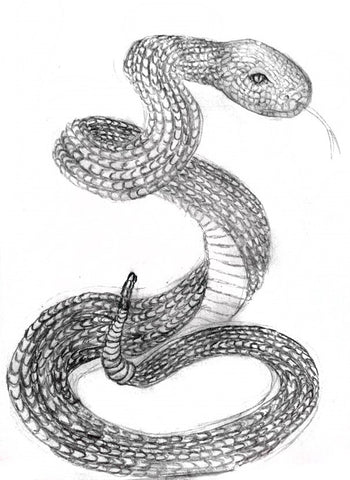How To Draw Scales On A Snake
Cartoon a figure with obvious planes (flat surfaces) is easily perceptible by short observations because the details are laid flat and the sides are polygonal,But snakes are basically cylindrical which makes the prints and body embellishments harder to convey, adapt and place accordingly. Aside from the challenge of figuring out the cylindrical shape of snakes, another challenge is the way the snake bends and moves. The patterns on its body are either slightly stretched or compressed, changing the shapes of the details and slightly rearranging the distinguishable form of the prints.
The easy solution to this is to convey the cylindrical effigy of its body first, map the shape and draw reference lines/curves.



Depict a cross- contour on the basic effigy to easily fix this trouble. Draw another set up of reference lines to found the distance/gap betwixt each print. When the complete mapping of the form (contour course of the snake) is established, the bends and curve of the figure can exist hands observed and the embellishments on its skin would be much easier to locate and found properly.

Imagine a fishnet wrapped tightly on a serpent effigy. The spaces effectually each diamond-shaped scales increase as the area it covers get bigger, like the Fishnet is being stretched further when it's covering an expanse with a wider mass. Merely call up that the sizes of each calibration are consistent, only the picayune gaps or spaces between each one are adjusted when it bends or turns.

It may take a while when drawing the details of a snake'due south torso, but you should remain patient and initiate the detailing properly to avoid sloppy hand strokes.
Skins of snakes are basically scales with diamond shapes or semi-ovals, the manner of how each rows of scales menstruum around the entire shape of the subject depends on how the snake twists its torso while in motility. The rows are usually horizontal if the trunk of the snake is not curled or bent, but it changes into diagonal rows when the body is turned, which makes the pattern of the scales similar to fishnets.

In that location are few ways to easily establish the rows of scales. The reference marks applicable depend on the current motility/gesture of the subject and how the shape of each calibration, including other unique prints that some snakes are known to have, should be established.

Loops that cantankerous the entire figure is effective for seeing the entire mass of the figure. In this way, you lot can hands decide how the certain prints and scales should wrap the shape of the snake (how it should fold or bend) and how far the details should be apart from the other.

Proper gradation is vital when yous visually draw the texture in black and white.
Keep in mind that these reference marks are mere guides to easily visualize the body details of the subject. There are cases (usually because of a certain body gesture) which some portions are better conveyed past close observations to an bodily subject or at to the lowest degree a photo.



A thorough explanation and easy to follow step-by-step instructions are available in the book "Drawing Snakes - How to Describe Snakes For the Beginner".
https://l2draw.com/collections/drawing-for-beginners/products/drawing-snakes-how-to-draw-snakes-for-the-beginner
Examples are besides included in "Cartoon Snakes and Lizards"
https://l2draw.com/collections/drawing-for-beginners/products/drawing-snakes-and-lizards-how-to-draw-reptiles-for-the-beginner
Source: https://l2draw.com/blogs/news/drawing-snakes-how-to-draw-snakes-for-the-beginner
Posted by: ligginsrebt1940.blogspot.com


0 Response to "How To Draw Scales On A Snake"
Post a Comment